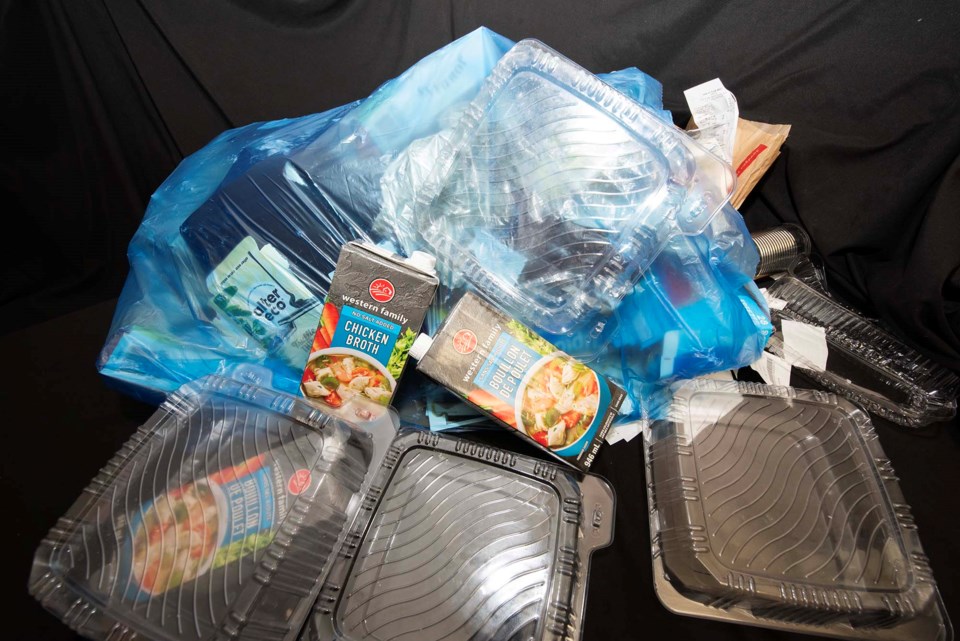Correction
This story originally said that "more items such as flexible plastic bags for frozen fruit" would be added to EPR in the future, based on information from Jennifer Koole. Koole has since said she misspoke, as such plastic bags are already covered by EPR. This story has been updated with the correct information. The Gazette apologizes for the confusion.
St. Albert residents will finally get to chuck plastic clamshells into their blue bags this Tuesday as a new province-wide recycling system kicks in — one that should save people money on their utility bills.
Alberta’s new extended producer responsibility (EPR) framework for waste kicks in this Tuesday April 1. The system requires producers of single-use products, paper, packaging, and household hazardous and special products to manage and pay for the recycling of those items to keep them out of the landfill.
Municipalities currently have to run their own recycling programs to collect, process, and sell these materials, with taxpayers footing the bill. As of April 1, those costs and duties will be taken on by various producer groups.
“It put that onus back on those who created the product,” said Jennifer Koole, executive director of the Recycling Council of Alberta.
St. Albert is part of the first wave of communities getting EPR in Alberta, which includes every place that had depot and/or curbside recycling as of Nov. 30, 2022. EPR rolls out everywhere else on Oct. 1, 2026.
St. Albert residents won’t notice a huge shift at the curb next week as this city has elected to keep running its own recycling programs, said John Potter, the city’s manager of waste management. (Under EPR, communities can either have industry groups pay for existing recycling programs or have them take them over entirely.)
“It’s basically going to be status-quo on April 1,” he said, apart from two new items that will be allowed in the blue bag.
“What’s changing is who pays for that.”
More bag, less bucks
All Albertans will have access to the same base level of recycling no matter where they live under EPR, which should make recycling less confusing, Potter and Koole said.
It also means more items qualify for curbside recycling. Potter said plastic clamshells and non-beverage tetra packs will be accepted in the blue bag as of April 1 under EPR, which should keep more waste out of the landfill and reduce greenhouse gas emissions associated with waste disposal.
Potter said St. Albert residents will see a “quite significant” drop in the $6.54 monthly fee they currently pay for recycling once EPR kicks in, as industry will now foot the bill for most recycled items. It will not eliminate the fee, as the city still has to pay for services it offers not covered by EPR (such as Styrofoam recycling). Potter was still calculating the new fee as of this week but planned to bring it to council for approval soon.
Potter said he was excited to see EPR come online, as Alberta was one of the last places in Canada to implement it.
Other jurisdictions with EPR have found it pushes manufacturers to change their products to be more recyclable, Koole said. It also makes it more economical to recycle, as producers can take an entire province’s worth of material to market instead of just one city’s.
A 2019 study commissioned by what is now Alberta Municipalities found that EPR would save Albertans an additional $4.7 million a year in recycling costs and keep an additional 20,900 tonnes of paper and packaging products out of the landfill each year. This would create about 219 more recycling jobs and prevent some 71,900 more tonnes of greenhouse gas emissions a year — equivalent to keeping 16,771 cars off the road for a year, the U.S. Environmental Protection Agency estimates.
Koole said more items will be added to EPR in the years ahead. Toronto has EPR, for example, and it recently started accepting disposable coffee cups for recycling.
Visit stalbert.ca/home/waste or email [email protected] for information on EPR and recycling in St. Albert.




